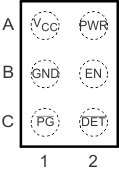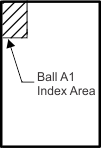SLVS788D February 2009 – November 2016 TPS22951
PRODUCTION DATA.
- 1 Features
- 2 Applications
- 3 Description
- 4 Revision History
- 5 Pin Configurations and Functions
- 6 Specifications
- 7 Parameter Measurement Information
- 8 Detailed Description
- 9 Application and Implementation
- 10Power Supply Recommendations
- 11Layout
- 12Device and Documentation Support
- 13Mechanical, Packaging, and Orderable Information
Package Options
Mechanical Data (Package|Pins)
- YFP|6
Thermal pad, mechanical data (Package|Pins)
Orderable Information
5 Pin Configurations and Functions
YFP Package
6-Pin DSBGA
Top-Through View

YFP Package
6-Pin DSBGA
Top View

Pin Functions
| Pin | I/O | DESCRIPTION | |
|---|---|---|---|
| NO. | NAME | ||
| A1 | VCC | I | Supply voltage |
| A2 | PWR | O | Power switch output |
| B1 | GND | — | Ground |
| B2 | EN | I | Enable input (1) |
| C1 | PG | O | Power Good switch status open-drain output, active low |
| C2 | DET | I | Accessory detect, active low |
(1) DET must be low for a minimum of 2 μs before EN is pulled high (see the Timing Requirements section).